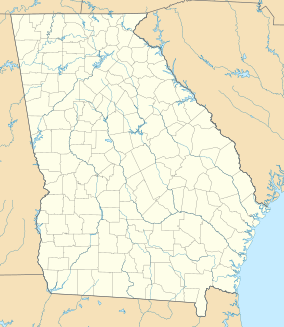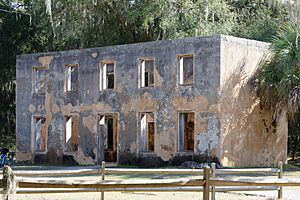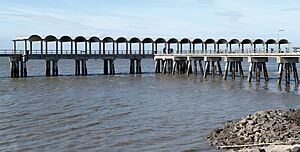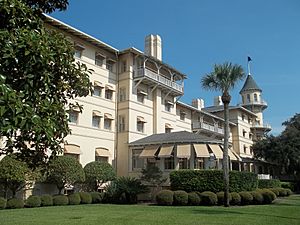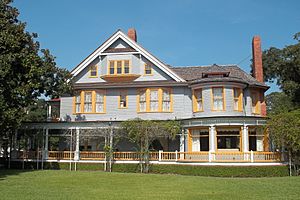Jekyll Island facts for kids
Quick facts for kids Jekyll Island |
|
|---|---|
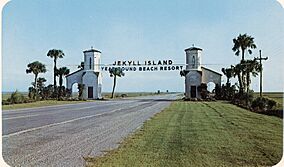
The original entrance to the state park
|
|
| Location | Glynn County, Georgia, U.S. |
| Nearest city | Brunswick, Georgia |
| Established | October 7, 1947 |
| Governing body | Jekyll Island Authority |
Jekyll Island is a beautiful island located off the coast of Georgia in the United States. It is one of the Sea Islands and part of the Golden Isles of Georgia, which are barrier islands that protect the mainland from ocean storms. The State of Georgia owns Jekyll Island. It is managed by a special group called the Jekyll Island Authority.
For a long time, Native American tribes used the island during different seasons. The Guale and Mocama people lived here when Europeans first arrived. Later, English settlers and French pirates caused these native groups to leave. Plantations were built on the island during the time when Britain ruled the area. Some old buildings are still standing and were made from a special material called tabby, which uses crushed oyster shells.
In the late 1800s and early 1900s, the island became a popular place for wealthy people to visit. During World War II, the U.S. government asked everyone to leave for safety. In 1947, the state of Georgia bought the entire island to protect it.
Today, Jekyll Island is a very popular tourist destination. Many people enjoy its wide beaches. You can take guided tours of the Landmark Historic District. There are also bike trails, places to walk on the beaches, and a fun water park called Summer Waves. The historic district has many impressive old buildings from the late 1800s and early 1900s. The island is also home to lots of wildlife, including mammals, reptiles, and birds that live in the salt marshes. In 2018, Architectural Digest magazine called Jekyll Island one of the 50 most beautiful small towns in America.
Before the 2020 census, Jekyll Island was listed as a special area called a census-designated place. It had a population of 866 people.
Contents
Exploring Jekyll Island's Natural Beauty
Jekyll Island is one of only four barrier islands in Georgia that you can reach by car using a paved causeway. The island covers about 5,700 acres (23 km2) of land. This includes 4,400 acres (18 km2) of solid ground and a 240-acre (0.97 km2) area known as the Jekyll Island Club Historic District. The rest of the island is made up of marshlands, which are wet, grassy areas, mostly on the western side.
The island is about 7 miles (11 km) long and 1.5 miles (2.4 km) wide. Its eastern shore has 8 miles (13 km) of wide, flat beaches. The sand is firm, making it easy to walk or bike. There are also 20 miles (32 km) of hiking trails. Like other Golden Isles, Jekyll Island is mostly made of older land from the Pleistocene era. It also has smaller, newer sections from the Holocene era. The weather here is humid subtropical, meaning it's warm and wet. Most of the rain falls during the hottest months.
The Northern End of the Island
The northern part of Jekyll Island has seen the most human activity over the past few centuries. Early settlers and loggers built plantations here. They used trees to build ships. In the early 1900s, much of the wild land was turned into golf courses.
Clam Creek Picnic Area
A short, winding road leads to the Clam Creek Picnic Area. It is one of three picnic spots on the island. To the west, you can see a large marsh and the Sidney Lanier Bridge. This bridge is 480-foot (150 m) tall. A long fishing pier stretches out from the picnic area. To the east, a bridge crosses Clam Creek. It connects the picnic area to the North End Beach and Driftwood Beach. These beaches are known for a tidal creek and many old tree roots.
Horton House Ruins
The ruins of a two-story house built in 1742 stand along N. Riverview Road. This house was made from tabby, a special building material. Tabby is made from crushed oyster shells, lime, and water, like a type of cement. It was used for many old buildings along the coast. The house was lived in by Major William Horton during the British colonial period. He also started Georgia's first brewery nearby.
The remains of the Horton House have been carefully kept for over 100 years. It shows how people built things in coastal Georgia long ago. It is one of the oldest buildings still standing in the state. Across the street is the du Bignon cemetery. This cemetery was started by the family who owned the house and much of the island later on. Its tabby wall surrounds the graves of five people from the 1800s.
Island Campground
Right across from the Clam Creek picnic area entrance is the campground. It is an 18-acre (73,000 m2) area in a cleared maritime forest. The campground has running water for restrooms, showers, and laundry. It also has a store and bike rentals.
The Southern End of the Island
The southern part of the island was not used much by settlers until the late 1800s. At that time, the army put a gun mount there during the Spanish–American War. It watched over St. Andrews Sound. In the second half of the 1900s, homes and motels were built by the Jekyll Island Authority along the northern beaches. The many sand dunes at the very southern tip were formed by sand moving from the eroding northern beaches.
South Dunes Picnic Area
This picnic area is on the ocean side of the island. It has many picnic tables and a full bathroom with showers. A boardwalk helps you cross the 20-foot (6.1 m)-high sand dune to reach the beach. This dune helps protect the trees and the inside of the island from storms. In 1983, this area was fixed. Bulldozers pushed new dunes into place to repair damage caused by people walking over the dunes for 30 years.
Glory Beach
You can get to Glory Beach by walking on a long boardwalk. This boardwalk was built in the mid-1980s for the movie Glory, which was partly filmed here. The beach was named after the movie. The boardwalk has been repaired recently. You can reach it from the soccer complex at the south end of Jekyll Island. The boardwalk goes through different natural areas, from old dunes to freshwater swamps.
St. Andrews Picnic Area
St. Andrews is a picnic area on the intercoastal side of the island. It faces the marsh and the mainland. It is the farthest point on the beach from Clam Creek. This beach is very popular with fishing birds. Dolphins often come here to feed. You can see them when they come up for air.
In 2008, the Jekyll Island History Museum and other groups honored the survivors of the slave ship The Wanderer. This was one of the last ships known to bring enslaved people to the U.S. after it became illegal. The ship Clotilda brought 110 enslaved people in July 1860 and is considered the very last.
The Wanderer was first built as a pleasure boat. But it was bought by people who did not agree with the ban on the slave trade. They changed the ship to carry enslaved people from Africa. On November 28, 1858, The Wanderer arrived near the southern part of Jekyll Island. Its crew brought 409 to 465 enslaved Africans ashore. This caused a lot of anger. The government tried to punish those involved, but it was not successful.
A large steel sculpture of ship sails was made for this site. It is 12-foot (3.7 m) tall. It is meant to show the harshness of slavery.
Jekyll Island Club Historic District
In the middle of the island, on the side facing the mainland, is a special 240-acre (0.97 km2) Historic District. This area includes most of the buildings from the time of the Jekyll Island Club. These buildings have been carefully saved. The main building is the large Jekyll Island Club Hotel. It has two wings and many rooms to rent. The presidential suite has a three-story turret on the front.
Thirty-three buildings from the late 1800s and early 1900s surround the hotel. Many of these are huge "cottages" built by very rich people. Some cottages offer rooms for rent. Others have been turned into museums, art galleries, or bookstores. The hotel is listed on the National Register of Historic Places. The historic district itself became a National Historic Landmark District in 1978.
Tram tours start from the Jekyll Island Museum. They run several times a day. Guides tell many stories about the history of this area.
Jekyll Island's Past
In the middle of the 1400s, the island now called Jekyll was near the border of the Guale and Mocama people's lands. Historians have discussed whether the town of Guadalquini was on Jekyll Island or St. Simon's Island. They also debate if the people living there in the late 1500s were Guale or Mocama. By the early 1600s, the Mocama lived in Guadalquini. Both the Guale and Mocama became part of the Spanish mission system. In the late 1600s, the Guale and Mocama were forced out of what is now Georgia. This happened because of attacks from French pirates and Native American allies of the English. The survivors moved to what is now Florida.
The men used spears to catch fish from the creeks. The women knew a lot about the local plants. They gathered nuts and fruit. They also made a type of tea from roasted holly leaves. These early people also grew squash, pumpkins, beans, and corn. They grew sunflowers and tobacco too, which they used for many special ceremonies.
European Explorers Arrive
In 1510, explorers from Spain were the first Europeans to land on Jekyll Island. They named it Isla De Ballenas, meaning Whale Island. Later, Juan Ponce de León became the governor of this area for Spain. In 1562, French explorer Jean Ribault claimed the island for France. He renamed it Ille de la Somme. Ribault later gave up to the Spanish and was killed. Spain and France fought over the Georgia and Florida coasts. After his army quickly defeated the French, Philip II of Spain immediately started a colony on Jekyll.
More small fights between Spain and France happened along the coast. Spanish priests set up missions to teach Native Americans about Christianity. No mission is known to have been built on Jekyll. However, the Spanish influenced the island from their mission on St. Simons Island. After an invasion by the Westo tribe, they began destroying the missions and killing the Spanish priests. They spared Father Xander Davilla on Jekyll, keeping him as a slave. He was later freed in a prisoner exchange.
Between 1663 and 1665, England claimed land stretching south from their Jamestown colony. This land went down to an area below St. Augustine, Florida. The English made friends with the Cherokee people, Creek people, and Yuchi tribes. They gave weapons to these warriors. They told them to attack the Spanish and Muskogean settlements on Jekyll between 1681 and 1683. By 1702, the English had driven the Spanish out of the entire area.
English Control and Plantations
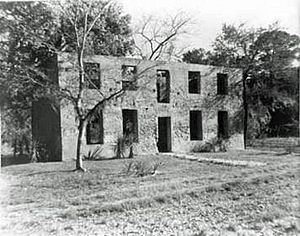
General James Oglethorpe started Georgia as a colony in 1733. He renamed the island in honor of his friend Joseph Jekyll. Joseph Jekyll had given £600 to help start the colony. For many years, the island's name was spelled "Jekyl." In 1929, the Georgia government passed a law to change the spelling to "Jekyll," as used by the person it was named after.
In the late 1730s, General Oglethorpe asked William Horton to set up a military post. This post would protect Fort Frederica on St. Simon's Island. By 1738, Horton had made Jekyll Island his permanent home. He lived near what is now called DuBignon Creek. Horton started a plantation at his home. This plantation provided food like beef and corn for the people at Frederica. He used the labor of enslaved African Americans.
Horton continued to develop his land on Jekyll Island. In 1742, his house was destroyed during Spanish attacks. But he had it rebuilt. He also tried growing new crops on his plantation, like barley and indigo. Horton rebuilt his house and other buildings using tabby. This strong building material is a mix of lime, crushed oyster shells, and water. It has lasted a very long time on the Sea Islands. The outside of William Horton’s two-story tabby house is one of only two colonial-era two-story buildings left in Georgia. William Horton died around 1748 or 1749. His property on Jekyll was owned by many people. Then, just before 1800, Christophe du Bignon bought all the land on the island.
The Plantation Era
Christophe du Bignon and his family came to Jekyll Island from France in 1792. They were escaping the violence of the French Revolution. Du Bignon built a successful plantation that relied on slavery. After he died in 1825, his son Henri Charles Du Bignon took over the property. Under Henri Charles, the plantation continued to do well, as shown by the 1850 census.
On November 28, 1858, the ship The Wanderer landed on Jekyll Island with 465 enslaved people. This happened 50 years after it became illegal to bring enslaved people to the United States. This was the second-to-last successful shipment of enslaved people from Africa to American soil.
By 1860, the plantations on Jekyll were not producing as much. Markets had changed, and the soil was worn out. By 1862, when Union Army troops arrived, the Du Bignon plantation was completely empty. After the American Civil War ended, the Du Bignon family returned to the island. Henri Charles divided the island among his four children.
In 1875, John Eugene Du Bignon, a nephew, became an owner of land on the island. He inherited the southern third of the island from his father. He planned to build a house there.
The Jekyll Island Club Era
John Eugene Du Bignon bought the rest of the island from his siblings. He did this with help from his brother-in-law Newton Finney and an investor. Their idea to make the island a winter getaway for rich people came true on February 17, 1886. They decided to build a clubhouse, which was finished in January 1888. Fifty-three members bought shares for $600 each. They limited the club to 100 members to keep it very exclusive.
From 1888 to 1942, the club opened every January for the winter season. It only closed for a few years due to yellow fever outbreaks. The club hosted some of the world's wealthiest people. Members and their families enjoyed activities like biking, hunting, horseback riding, and tennis. They also spent time on the north beaches. Some of the richest members built their own "cottages," which were huge mansion-sized homes. Many of these are still standing today.
Even wealthy people lost money during the Great Depression. The club also faced financial problems. When the United States entered World War II, the government ordered everyone to leave the island for safety. This ended the Jekyll Island Club era. After the war, in 1947, the State of Georgia bought the island.
Planning the Federal Reserve System
In November 1910, a secret meeting took place at the Jekyll Island Club. Senator Nelson W. Aldrich, Assistant Secretary of the U.S. Treasury Department A. Piatt Andrew, and five important bankers attended. They were Frank Vanderlip, Henry P. Davison, Benjamin Strong, and Paul Warburg. Their goal was to plan the country's money system and banking. During this meeting, they developed the idea for the Federal Reserve. This would be America's new central bank.
The Federal Reserve Bank of Atlanta states that the 1910 Jekyll Island meeting led to a draft law for a U.S. central bank. Some people believe that parts of this plan, called the Aldrich plan, were used in the 1913 Federal Reserve Act. However, officials from the Federal Reserve System have said that the final law was designed to fix problems found in the Aldrich Plan.
The Jekyll Island Authority
The state of Georgia took control of Jekyll Island on October 6, 1947. Governor Melvin E. Thompson was in charge. The state paid $675,000 for the island. At first, the island was managed as part of the State Park system. But by 1950, it cost a lot to get the island ready for tourists. So, the island was removed from the state park system. It was given to a separate group called the Jekyll Island Authority. The goal was for the island to support itself financially.
The Jekyll Island Authority was created in February 1950. Governor Herman Talmadge led this effort. It was set up as a governing board. This board had nine members chosen by the governor. Their job was to operate and care for the island. Black residents of Brunswick asked the state for access to the island. In 1950, a part of southern Jekyll, renamed St. Andrews Beach, was set aside for Black people. It became the first public beach in Georgia that African Americans could use. Five years later, the state built the “Colored Beach House,” which is now a historic landmark at Camp Jekyll.
In 1951, the Authority put a convict camp on the island. This system, where prisoners were leased for labor, was similar to slavery in its unfairness. Mostly African-American prisoners did the hard work to prepare the island for public use. They planted trees for drainage, dug foundations for motels and neighborhoods, and built the main road around the island. From September 1951 to December 1954, the island was mostly closed to the public. After a six-year project to build the causeway and a drawbridge, Jekyll Island officially reopened on December 11, 1954.
The Authority faced criticism and bad publicity in the mid-1950s. In 1957, the Georgia Legislature changed how the Authority was structured. They required board members to be elected officials. The state attorney general, state auditor, public service commissioner, state parks department director, and secretary of state all became board members.
In the next ten years, the Authority oversaw the building of motels, houses, a convention center, and a shopping center. They also built the towers at the entrance to the causeway. In the 1970s, the Authority started fixing up the historic cottages and the club hotel. During the 1980s, they supervised the building of bike paths. The clubhouse reopened in December 1987. The legislature changed the board members again in the 1970s and 1980s. Now, the board includes the Commissioner of the Georgia Department of Natural Resources and eight citizens of the state.
Some newer projects include the Soccer Complex and the Jekyll Island Tennis Center. The island gained Historic District status and was named a National Historic Landmark in 1978. The Jekyll Island 4-H Center opened in 1983. Most recently, the Authority finished building the Georgia Sea Turtle Center. This center helps injured turtles, especially the critically endangered Kemp's ridley sea turtle, and releases them back into nature.
Since the late 1900s, fewer people have visited the island because there are more competing places to go. In 2006, the Authority planned to make the island popular again. In 2007, they chose a private company, Linger Longer Communities LLC, to help redevelop part of the island. After a year of planning and public meetings, the Authority and Linger Longer created a revitalization plan. This plan includes a renovated Convention Center and a new Beach Village. The Beach Village will have new shops and a public beach-side walkway. By law, 65% of the island must stay in its natural state, including parks and picnic areas.
For many decades, there has been a daily toll to enter Jekyll Island. In 1985, it cost $1. By August 2009, it was $5, and later it was raised to $10. An annual pass costs $100. You can buy an annual pass at the Guest Information Center before entering the island.
Demographics
|
Jekyll Island
|
|
|---|---|
| Country | United States |
| State | Georgia |
| County | Glynn |
| Population
(2020)
|
|
| • Total | 866 |
| Time zone | UTC−6 (Central (CST)) |
| • Summer (DST) | UTC−5 (CDT) |
| Historical population | |||
|---|---|---|---|
| Census | Pop. | %± | |
| 2020 | 866 | — | |
| U.S. Decennial Census 2020 |
|||
Jekyll Island was first listed as a census designated place in the 2020 U.S. Census.
| Race / Ethnicity (NH = Non-Hispanic) | Pop 2020 | % 2020 |
|---|---|---|
| White alone (NH) | 823 | 95.03% |
| Black or African American alone (NH) | 0 | 0.00% |
| Native American or Alaska Native alone (NH) | 1 | 0.12% |
| Asian alone (NH) | 3 | 0.35% |
| Pacific Islander alone (NH) | 0 | 0.00% |
| Other race alone (NH) | 1 | 0.12% |
| Mixed race or Multiracial (NH) | 22 | 2.54% |
| Hispanic or Latino (any race) | 16 | 1.85% |
| Total | 866 | 100.00% |
Jekyll Island in Movies and TV
Jekyll Island has been a filming location for several movies and TV shows. Scenes from the films X-Men: First Class, Glory, and The Legend Of Bagger Vance were filmed here. The movie Jekyll Island and The View from Pompey's Head also used the island. On October 27, 2014, Red Zone Pictures filmed parts of Magic Mike XXL (2015), starring Channing Tatum, on the island.
In 2016, an episode for The Walking Dead Season 7 was filmed on the island. Part of an episode in season 10 was also filmed here in 2019. In 2021, some scenes for The Menu were filmed on Driftwood Beach. The musical movie The Color Purple (2023) shot several scenes on Driftwood Beach in March 2022.
Transportation on the Island
Jekyll Island has a small airfield for planes.
Images for kids
See also
 In Spanish: Isla Jekyll para niños
In Spanish: Isla Jekyll para niños


